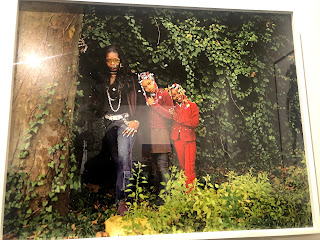Jada Cox
December 3, 2019
Constructing Identity
To construct identity means to create a version of yourself or another that no one can alter because it is something they themselves constructed. The art pieces that were in the gallery were constructed by the artist from their own point of view. The art is then perceived by an audience who continues to construct the identity of the art. But this still does not change the identity of the art that the artist created.
To understand this concept of constructing identity John Berger's book, Ways of Seeing explains it perfectly."The paint cannot free itself of its original propensity to procure the tangible for the immediate pleasure of the owner."(Page, 92) The paint is used as a tool to construct an identity of the artist, but the paint is also used for the consumer's consumption. As an artist, you cannot take away the fact that the consumer is going to reconstruct what they see and create their own identity for the piece. But the amazing thing about art in a gallery is that that art cannot be changed, so the constructed identity that the artist created will always remain the same for themselves until they create another piece. Each artistic piece that an artist uses to construct an identity adds another lost story to mankind's history and no matter what the picture is showing if an identity is being constructed then that in itself is challenging some type of stereotype or norm in the world.
All the artists I chose to utilize tools to create and restructure or completely structure an identity, a culture, a group of people, a lifestyle while adding to history itself.
Artist: Neal Slavin: K&P Distributors, Inc. Sabrett Food Products Corporation, New York, 1979
Slavin creates an identity where identities may not be obvious or even searching to be seen. Slavin looks for togetherness or the ability to group through likeness meaning religion, occupation, hobbies and anything else one can imagine. If you look closely in this picture none of the men look as though they are related. They all may come from different backgrounds, but what brings them together is their distribution of hotdogs. Coming from someone who has visited New York plenty of times there is a stereotype of what type of people sell art the cart stands. We develop stories for these people and place formed identities for them. This image pushes back at all those stories and identities ever thrown their way. It shows that the distribution of hotdogs isn't done by one group of people, but anyone who chooses to.
Artist: Alice Neel: Isabel Bishop, 1974
Alice Neel recreates images of people and emphasizes parts that aren't normally want to be seen by the woman or are even a normal thing to emphasize for the patriarchal society. In this oil painting, Neel adds extra detail in the veins and bones of the woman's hands. She also makes sure she adds aged features into the woman's face. To me, this photo represents true beauty, and the fact of true beauty is that people age and the beauty never fades, it simply goes along with the time. This painting is one of my favorites because it criticizes the saying of 'beauty fades' and the long-standing male gaze on how a woman should age.
Artist: Dawoud Bey: Smokey, 2001
Dawoud's approach to his photography is one that I appreciate so much. He gives his model and the consumer the ability to construct their identity. Dawoud's purpose is to create a space and an opportunity for a different narrative and identity to be constructed. In my opinion, Dawoud allows his images to change history and the way the world sees specifically urban youth and those communities. Giving the young man Smokey a luscious green background compared to the hard exterior people are used to seeing allows for a different identity to be constructed.
Artist: Deana Lawson: Wanda and Daughters, 2009
Before getting into this image I found it interesting how both Dawoud and Deana utilize natural, green, motherly elements. Showing different elements other than a "concrete jungle" allows people to think outside the box and construct a different narrative. Deana designed this scene to showcase different beauty. In a patriarchal society, beauty isn't seen in images as black girls with beads, or a mom with piercings. Deana is adding to the status quo of beauty while challenging all standards.
Artist: Bisa Washington: Never Forget, 1999
Bisa Washington's print work symbolizes many things. The main focus is optimism in the field of cruelty. The figures symbolize slavery and bigotry that has taken a toll on the African American community. But the hands and the words in the background represent the love overcoming the cruelty. Bisa is showing history how it is, but also adding another level of how the African American culture fought through it all through love.
In conclusion, identity is constructed using various tools to create and define a culture, person, group, and anything else to be thought of. Identity is socially constructed, but through art, people can take that control back and reconstruct an identity of their own.






No comments:
Post a Comment